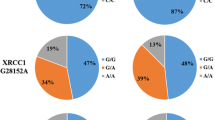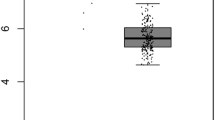Abstract
Background
P53 and ATM are central checkpoint genes involved in the repair of DNA damage after ionising irradiation, which has been associated with risk of brain tumours. Therefore, we tested the hypothesis that polymorphisms and haplotypes in p53 and ATM could be associated with glioma and meningioma risk.
Material and Methods
Six hundred and eighty glioma cases (298 glioblastoma (GBM)), 503 meningioma cases, and 1555 controls recruited in the Nordic-UK Interphone study, were analysed in association with three polymorphisms in p53 (rs2287499, rs1042533, rs1625895) and five polymorphisms in ATM ( rs228599, rs3092992, rs664143, rs170548, rs3092993). Haplotypes were constructed using the HAPLOSTAT program.
Results
The global statistical test of glioblastoma and p53 haplotypes was p = 0.02. The haplotype analysis on glioblastoma revealed the 1-2-2 haplotype (promotor-codon72-intron 6) had a frequency of 6.1% in cases compared with 9.8% in controls (p = 0.003).The 1-2-1 haplotype was significantly more frequent in GBM cases, 10.2%, than in controls, 7.3% (p = 0.02). The haplotype analysis in ATM revealed an increased frequency of the 1-1-1-2-1 haplotype in meningioma cases (33.8%) compared with controls (30.3%) (p = 0.03). The 2-1-2-1-1 haplotype had a lower frequency in meningioma cases (36.1%) than controls (40.7%) (p = 0.009).
Conclusions
This study found both positive and negative associations of haplotypes in p53 for glioblastoma and ATM for meningioma. This study provides new data that could add to our understanding of brain tumour susceptibility.
Similar content being viewed by others
References
Lowe SW, Cepero E, Evan G (2004) Intrinsic tumour suppression. Nature 432(18):307–315
Bartkova J, Horejsi Z, Koed K, al (2005) DNA damage response as a candidate anti-cancer barrier in early human tumourigenesis. Nature 434:864–870
Bourguignon MH, Gisone PA, Perez MR et al (2005) Genetic and epigenetic features in radiation sensitivity Part I: Cell signalling in radiation response. Eur J Nucl Med Mol Imaging 32:229–246
Malkin D, Li F.P, Strong L et al (1990) Germ line p53 mutations in a familial syndrome of breast cancer, sarcomas, and other neoplasms. Science 250:1233–1238
Gatti RA, Lange E, Rotman G et al (1994) Genetic haplotyping of Ataxia-telangiectasia families localises the major gene to an approximately 850 kb region on chromosome 11q23.1.Int J Radiat Biol 66:S57–S62
Angele S, Romestaing P, Moullan N et al (2003) ATM haplotypes and cellular response to DNA damage: association with breast cancer risk and clinical radiosensitivity. Cancer Res 63:8717–8725
Thompson D, Duedal S, Kirner J et al (2005) Cancer risks and mortality in heterozygous ATM mutation carriers. J Natl Cancer Inst 97:813–822
Olsen JH, Hahnemann JM, Borresen-Dale AL et al (2005) Breast and other cancers in 1445 blood relatives of 75 Nordic patients with Ataxia telangiectasia. Br J Cancer 93:260–265
Ron E, Modan B, Boice JD Jr et al (1988) Tumours of the brain and nervous system after radiotherapy in childhood. N Engl J Med 319:1033–1039
Sadetzki S, Chetrit A, Freedman L et al (2005a) Long-term follow-up for brain tumour development after childhood exposure to ionising radiation for tinea capitis. Radiat Res 163:424–432
Wrensch M, Kelsey K, Liu M et al (2005) ERCC1 and ERCC2 polymorphisms and adult glioma. Neurooncology 7:495–507
Wang LE, Bondy ML, Shen H et al (2004) Polymorphisms of DNA repair genes and risk of glioma. Cancer Res 64:5560–5563
Malmer B, Feychting M, Lonn S et al (2005) p53 Genotypes and risk of glioma and meningioma. Cancer Epidemiol Biomarkers Prev 14:2220–2223
De Roos AJ, Rothman N, Inskip PD et al (2003) Genetic polymorphisms in GSTM1, -P1, -T1, and CYP2E1 and the risk of adult brain tumors. Cancer Epidemiol Biomarkers Prev 12:14–22
Wrensch M, Kelsey KT, Liu M et al (2004) Glutathione-S-transferase variants and adult glioma. Cancer Epidemiol Biomarkers Prev 13:461–467
Cardis E, Kilkenny M (1999) International case-control study of adult brain, head and neck tumours: results oradiat. Protect Dosimetry 83:179–183
Tamimi RM, Hankinson SE, Spiegelman D et al (2004) Common Ataxia Telangiectasia mutated haplotypes and risk of breast cancer: a nested case-control study. Breast Cancer Res 6:R416–R422
Lindstrom S, Wiklund F, Jonsson BA, Adami HO, Balter K, Brookes AJ, Xu J, Zheng SL, Isaacs WB, Adolfsson J, Gronberg H (2005) Comprehensive genetic evaluation of common E-cadherin sequence variants and prostate cancer risk: strong confirmation of functional promoter SNP. Hum Genet 118(3–4):339–347
Schaid DJ, Rowland CM, Tines DE, et al. (2002) Score tests for association between traits and haplotypes when linkage phase is ambiguous. Am J Hum Genet 70:425–434
Besag Clifford JP, (1991) Sequential Monte Carlo p-values. Biometrika 78:301–304
Sjalander A, Birgander R, Saha N et al (1996) p53 polymorphisms and haplotypes show distinct differences between major ethnic groups. Hum Hered 46:41–48
Wang WY, Barratt BJ, Clayton DG, Todd JA (2005) Genome-wide association studies: theoretical and practical concerns. Nat Rev Genet 6(2):109–118
Walter AW, Hancock ML, Pui CH et al (1998) Secondary brain tumors in children treated for acute lymphoblastic leukemia at St Jude Children’s Research Hospital. J Clin Oncol 16:3761–7
Biros E, Kalina I, Kohut A et al (2002) Allelic and haplotype frequencies of the p53 polymorphisms in brain tumor patients. Biros Physiol Res 51:59–64
Wu X, Zhao H, Amos CI et al (2002) p53 Genotypes and Haplotypes Associated With Lung Cancer Susceptibility and Ethnicity. Natl Cancer Inst 1;94:681–690
Storey A, Thomas M, Kalita A et al (1998) Role of a p53 polymorphism in the development of human papillomavirus-associated cancer. Nature 21;393:229–234
Ojeda JM, Ampuero S, Rojas P et al (2003) p53 codon 72 polymorphism and risk of cervical cancer. Biol Res 36:279–83
Jee SH, Won SY, Yun JE et al (2004) Polymorphism p53 codon-72 and invasive cervical cancer: a meta-analysis. Int J Gynaecol Obstet 85:301–308
Coates PJ, Lorimore SA, Lindsay KJ, Wright EG (2003) Tissue-specific p53 responses to ionizing radiation and their genetic modification: the key to tissue-specific tumour susceptibility? J Pathol 201:377–388
Sadetzki S, Flint-Richter P, Starinsky S et al (2005b) Genotyping of patients with sporadic and radiation-associated meningiomas. Cancer Epidemiol Biomarkers Prev 14:969–976
Smilenov LB, Brenner DJ, Hall EJ (2001) Modest increased sensitivity to radiation oncogenesis in ATM heterozygous versus wild-type mammalian cells. Cancer Res 61:5710–5713
Malmer B, Tavelin B, Henriksson R et al (2000) Primary brain tumours as second primary: a novel association between meningioma and colorectal cancer. Int J Cancer 85:78–81
Bonnen PE, Wang PJ, Kimmel M et al (2002) Haplotype and linkage disequilibrium architecture for human cancer-associated genes. Genome Res 12:1846–1853
Sjalander A, Birgander R, Kivela A et al (1995) P53 polymorphisms and haplotypes in different ethnic groups. Hum Hered 45:144–149
Campbell CD, Ogburn EL, Lunetta KL et al (2005) Demonstrating stratification in a European American population. Nat Genet 37:868–872
Acknowledgments
All centres were supported by the European Union Fifth Framework Program “Quality of life and Management of Living Resources” (contract number QLK4-CT-1999-01563), and the International Union against Cancer (UICC). The UICC received funds for this purpose from the Mobile Manufacturers’ Forum and GSM Association. Provision of funds to the INTERPHONE study investigators via the UICC was governed by agreements that guaranteed INTERPHONE’s complete scientific independence. These agreements are publicly available at http://www.iarc.fr/ENG/Units/RCAd.html. The Swedish centre was also supported by the Swedish Research Council, the Cancer Foundation of Northern Sweden, the Swedish Cancer Society, and the Nordic Cancer Union. The Danish centre was supported by the Danish Cancer Society, the Finnish centre by the Emil Aaltonen Foundation and the Academy of Finland, The Cancer Society of Finland, and the UK centre by the Mobile Telecommunications and Health Research (MTHR) Programme. We also thank all patients, interviewers and team collaborators in the study in all participating countries.
Author information
Authors and Affiliations
Corresponding author
Rights and permissions
About this article
Cite this article
Malmer, B.S., Feychting, M., Lönn, S. et al. Genetic variation in p53 and ATM haplotypes and risk of glioma and meningioma. J Neurooncol 82, 229–237 (2007). https://doi.org/10.1007/s11060-006-9275-1
Received:
Accepted:
Published:
Issue Date:
DOI: https://doi.org/10.1007/s11060-006-9275-1




